Theoretical Framework of CRM
Peppers & Rogers (2004) and Ryals & Payne (2001) stated that customer relationship management is a strategic tool. Nowadays, many scholars like Berndt, Herbst & Roux (2005, p.2) and Pelland (2007) believed that CRM is a managerial philosophy. Berndt, Herbst & Roux (2005, p.2) further added that it seeks to develop long-term relationship with customers in order to increase sales.
Moreover, it develops the relationship with the different markets, including the final consumer (Berndt, Herbst & Roux, 2005; Peppers & Rogers, 2004; and Belch & Belch, 2009).
However, CRM is an information system that tracks customers’ interactions with the company (Nguyen, Joseph, Newby, 2007) that includes the use of technology in the building of databases (Peppers & Rogers, 2004; Urbanskienė, et al. 2008; and Nguyen, Joseph, Newby, 2007) that permits the staff of the company to directly pull up information about the target consumers (Santoso, 2008).
Most importantly, Oztaysi, Sezgin & Ozok (2011, p.1) and Kotler & Keller (2006) argued that the concept of 4P has developed as a tool for marketing accomplishment and considered conventional paradigm for marketing management, but background and the significance of CRM has developed with new shape under the present challenging economic condition.
However, CRM is an important factor to gather instant information about past sales, service records, performance records and unresolved problem calls (Oztaysi, Sezgin & Ozok, 2011; Santoso, 2006; and Nguyen, Joseph, Newby, 2007).
Thus, the applicable definition of CRM has generated as a procedure of maximizing customers’ value (Kotler & Keller, 2006; Peppers & Rogers, 2004; and Berndt, Herbst & Roux (2005) by concurrent marketing activities, integrating proper management of customer’s knowledge and information and relation with them (Belch & Belch, 2009 and Greenberg, 2009).
However, Pearson (2009, p.3) addressed the important elements of traditional CRM, such as, sales force automation, marketing automation, knowledge base and many other criteria described in figure one.
In this case, Pearson (2009) stated that sales force automation, telemarketing, product configuration, marketing campaign and support tracking were early drivers of CRM tools; on the other hand, customer portal or web-based customer access to the CRM structure is now a supreme requirement.
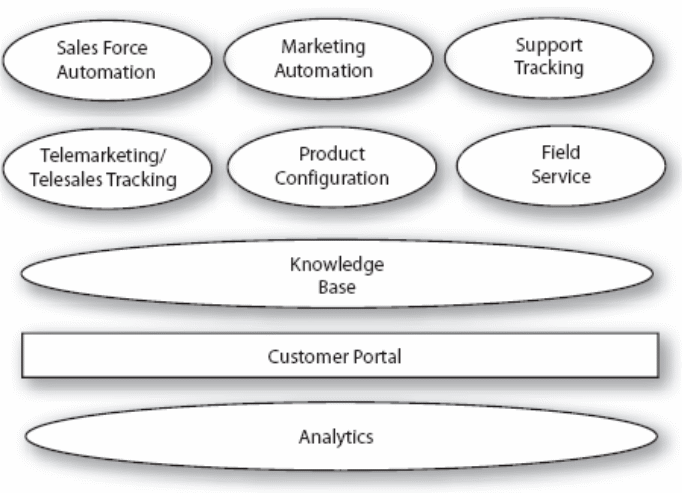
The Benefits of CRM
Pearson (2009, p.6-8) expressed that the advantages of CRM are often overstated particularly the owners of many small and medium sized companies considered it ineffective strategic tools and lose of investment.
However, the management of the large companies should concentrate on this issue considering benefits of the CRM, such as, cost savings, customer satisfaction and loyalty, maximization of profits, improved internal accountability, employee satisfaction and so on (Peppers & Rogers, 2004; Maklan, Knox & Peppard, 2007; Pearson, 2009; and Belch & Belch, 2009).
However, one of the most significant components of CRM is the level of customer satisfaction that yields the success of CRM program and first aim of CRM is to reduce cost as technology makes it easier to reach target customers (Maklan, Knox & Peppard, 2007; and Baran, Zerres & Zerres, 2009).
However, all business firms invest more to create customer equity as these firms strive for customer satisfaction (Pearson, 2009; Peppers & Rogers, 2004; and Baran, Zerres & Zerres, 2009). According to the statement of Baran, Zerres & Zerres (2009), the fundamental principle of this strategic tool is to achieving and retaining the loyal customers.
Failure of traditional CRM
Pearson (2009, p.13) stated that half of CRM projects was unsuccessful to bring on expected savings and competitive advantages and Oztaysi, Sezgin & Ozok (2011, p.2) the success rates of the existing projects of large companies was disappointing as success rates up and down from 10-30%.
However, Oztaysi, Sezgin & Ozok (2011, p.3) compared data of several companies to measure annual success rate from CRM projects, for instance, Positive return on CRM investments of Meta Group was only 10% in 2003, and success rate of CRM initiatives of Cap Gemini Ernst & Young was about 30%.
Greenberg (2010) addressed that CRM has glorious prospects in spite of a history of traditional CRM failures influence the companies to drive into CRM 2.0; however, following figure shows the reasons of CRM failures –

However, failure of traditional CRM projects not only encouraged the companies to develop CRM 2.0, but it raised questions regarding the effectiveness of implementation and evaluation process of CRM (Friedrich, Sprenger & Breitner, 2006).
Definition of SCRM
Chess Media Group (2010) identified that “Social Customer Relationship Management” is an extended part of Customer Relationship Management, and not necessarily a substitute; moreover, Baird and Parasnis (2011) states that SCRM appends value back to the consumers and deals with how strategy makers require to adjust to social-consumers together with their expectations in regard to firms where they have stake.
Baird and Parasnis (2011) further added that with a focus on strategy, consumer involvement and relations, SCRM steps ahead of administration of consumers, dealings, and capital; it turns into a buyer-engagement approach that upholds organizational aims and purposes towards amplification of consumer satisfaction.
Greenberg (2010) suggests that SCRM mainly comprises of an idea together with a corporate policy, backed via IT-platform, corporate regulations, procedure and communal-characteristics.
In addition, corporations formulate SCRM to connect with the consumers in a shared discourse with an aim of providing reciprocally advantageous services, based on reliant and clear business-atmosphere; to put simply, this is the firm’s rejoinder to the consumer’s rights on the discussion (Greenberg, 2010 and Chess Media Group, 2010).
Integration of Web 2.0
According to Tredinnick (2008) and Dimitroff (2006), through the conception of Web 2.0, the enduring and innermost intricacy of the speculation of CRM gains a new dimension through which the critique of the importance of the social networking media can have a high- level of exposure.
Customer Relationship Management over internet leads to consumer loyalty and for any organization, smart use of Web 2.0 can lead to successful involvement from the part of the customers (Desai, 2010; Oztaysi, Sezgin, & Ozok, 2011; Pearson, 2009; Myhill, Shoebridge, & Snoo, 2009; and Berndt, Herbst, & Roux, 2005).
O’Reilly (2005) stated that the idea of Web 2.0 integration started in a thorough discussion-session between O’Reilly and Media-Live-International; in the discussion, Dale-Dougherty pointed out the significance of incorporating web competently to better maintain tasks; therefore a clear distinction was made between Web 1.0 and Web 2.0, which forms the basis on which the concept of CRM 2.0 lies.
The following table shows these clearly defined distinctions put forward during the discussion session in order to assess the origin of the perceptions of CRM 1.0 and CRM 2.0:
Table 1: Clearly defined distinctions of Web 1.0 and Web 2.0 with example. Source: Self generated from O’Reilly (2005).
The evolution of CRM
Baran, Zerres & Zerres (2009, p.390) stated that it is important to measure CRM projects and tools, areas requiring measurement, quality of service, retention of customer or loyalty, customer cycle measures, company competence, efficiency and staff behavior.
The evolution of CRM 2
Due to the excessive workload on top-management and department heads to demonstrate an instant result with customer relationship management projects, traditional measures of customer insight are often derived from trailing indicators, for instance, return on investment (Greenberg, 2010; Greenberg, 2009; Baran, Zerres & Zerres, 2009; and Berndt, Herbst & Roux, 2005).
On the other hand, top-management of large companies also depend on the web analytics, which also outdated and fail to measure actual customer base, for instance, page views, number of clicks, renovation rates and page or site “tackiness” (Greenberg, 2010; Greenberg, 2009; and Baran, Zerres & Zerres, 2009). Many scholars evaluated CRM in different ways, for instance, Lieberman (2011) used following way –
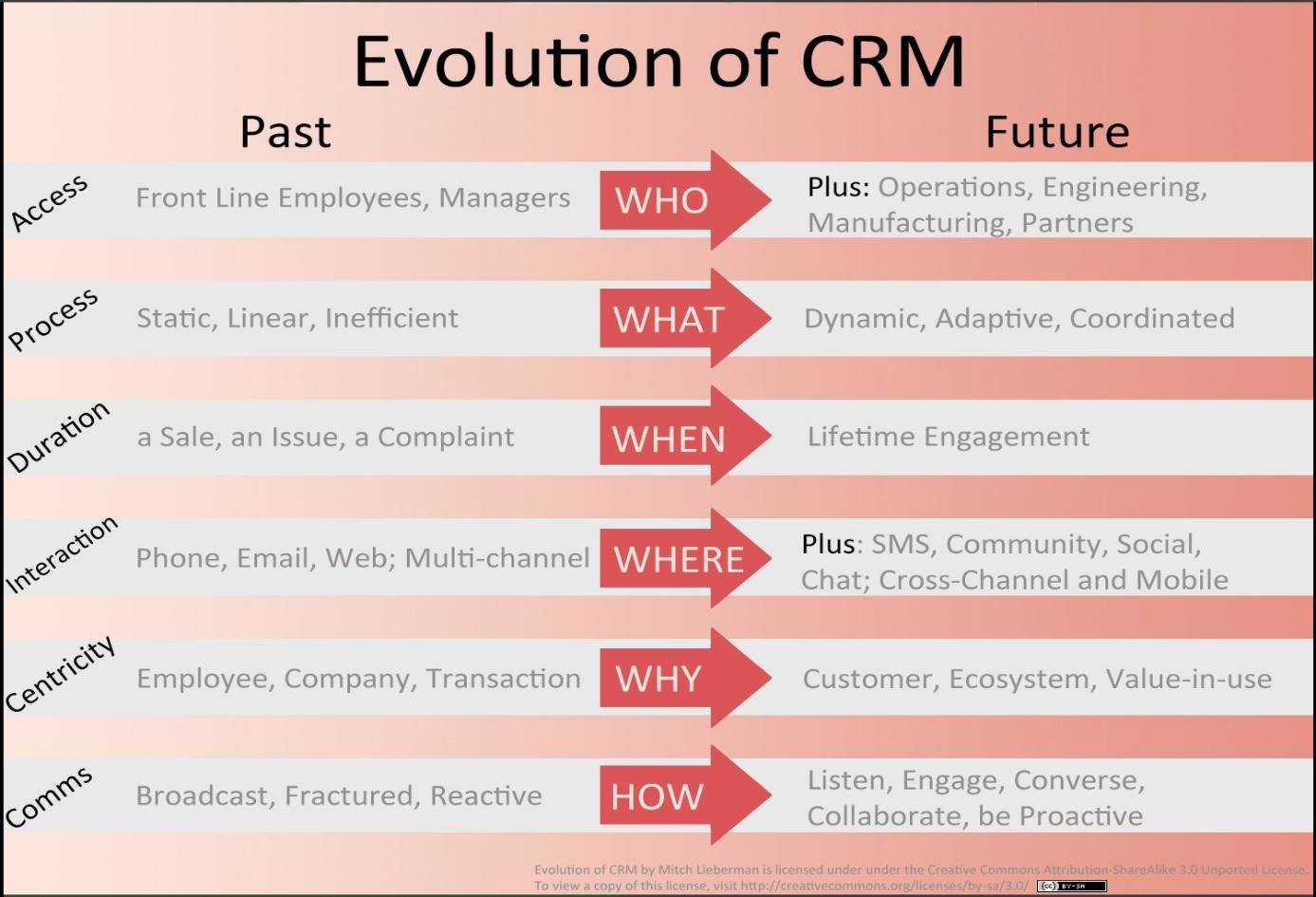
Who’ is about Access to data and systems
According to the Lieberman (2011) front line human resources and managers of different sectors are the only ones to have access to the technological components of customer relationship management as the companies are responsible for customer care along with privacy policy and data protection system, otherwise the companies may face legal problems due to lack of security measure.
However, Lieberman (2011), Greenberg (2010) and Baran, Zerres & Zerres (2009) pointed out that looking forward, giving access to information, and facilitating the business world by improving data management system, and gathering massive data in a single database.
In addition, the answer of this question “who would access to data and systems” is depend on the nature and duration of the business, relationship between employers and employees, database management system and many other factors;
What’ is all about the end-to-end Process
In the concurrent information technology integrated e-CRM, end-to-end process indicates the M2C that coordinated from manufacturer up to the end customer who consume the product or service, though there are other stakeholders, the end to end process of e-CRM would serve all of them without hampering the interest of any distribution channels.
In addition, inflexibility in procedure leads to inefficiencies (Kanellakis, 2005; Dych, 2001; and Laudon & Traver, 2002)
‘When’ is concerning the duration and strength of relationships
Baran, Zerres & Zerres (2009, p.398) stated that maintenance of long-term relationship with customer is one of the most important issues to evaluate the success of CRM projects and multinational companies would like to create lifetime value considering their future operation, for instance, Volkswagen has introduced customer relationship management tools in order to create lifetime value.
However, Lieberman (2011) and Baran, Zerres & Zerres (2009, p.398) further added that the companies should not provide more emphasis on the short-term sales growth, or negative feedback to measure progress of CRM activities rather they must consider the way to create lifetime value and long-term engagement;
In the traditional CRM practice to evaluate the outcomes of the system, the marketing practitioners has engaged to assess with customer satisfaction, while other practitioners emphasized to evaluate the CRM by using balanced score card, but in both evaluation it is difficult to quantify the level of achievement (Hampshire, 2010).
In the concurrent Information and Communication Technology (ICT) integrated e-CRM, there are a number of software like SAP those provide greater assortment of customized tools to evaluate the success of CRM by quantifying all concerned data.
Such software provide appropriate evaluation result with quantification and graphical representation taking into account of total customer’s visit, number of sales generation, amount of sales revenue with automated invoicing, after sales customers feedback and demonstrate if there is any change made due to customer’s feedback.
Moreover, the evaluation with SAP integrated CRM would enable the companies to deliver automated e- Newsletter to the customers with demonstrating the development scenario of CRM and the company’s concern in this regards without involving any human interference.
How CRM Involve
Parvatiyar and Sheth (2001, p. 6) mentioned that long efforts of the academia and scholars to identify how CRM involves in the modern corporation and to do so, a number of theoreticians like Borys & Jemison (1989, p.234-240), Wilson (1995, p.4-30) have presented several models those are chronologically developed.
Furthermore, models of CRM have come into practice to demonstrate the process how it involves, integrating most of them, this paper would present a four folded CRM practice framework encompass with a customer relationship configuration process at first, a course of action relationship governance at second layer; a relational evaluation system at third step and next a CRM evolution procedure.
Before going to the brief discussion, how CRM involves and functions in the modern business, the following figure demonstrates the process more clearly –
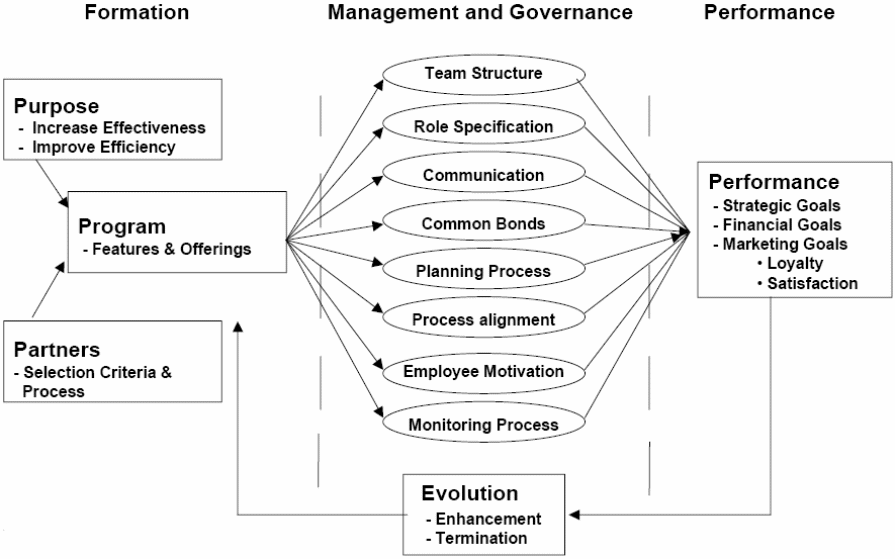
The CRM configuration Process
Doney and Cannon (1997, p. 41) argued that configuration procedures those the companies put into practice for CRM integration is the initiative to manage and administer the relational actions to their customers who have already been engaged with some purchase of product or service or going to purchase.
In the post purchase scenario, the companies are eager to employ in an accommodating or mutual relationship with the aim to retain while in the pre purchase step it drives to convey marketing message target customers. Companies would do the most significant congregation of categorized customers identifying them with different attributes of the individual groups by configuring the CRM process.
Within the configuration procedures of CRM, it has been identified three essential decision-making vicinities such as deciding the reason of involving with CRM, deciding the customer groups for whom the CRM scheme would be suitable; and budding different action plan to build effectual relationship with the potential customers.
Deciding the Reason of Involving with CRM and its Goals
Borys and Jemison (1989, pp. 235) pointed out that the general rationales of involving with CRM are to rise up the marketing efficiency along with improved reciprocal values for both the customer and company connecting through bilateral relationships in the marketplace.
The convalescing marketing is effectual along with generating shared values possibly would be gained next to the accelerating marketing success, while for the companies route to gaining such operational objectives are dependable on lesser distribution costs with reformed order handing system, dynamic inventory management scheme, with decreasing customer attainment cost comparing with expenditure for customer retention would provide superior marketing-efficiency.
There are so many processes to improve marketing efficiency for the companies starting from cautious choice and categorization of customers by addressing each customer’s individual needs, enhanced loyalty along with promise, pointing to the competitive advantage of the brand, offering innovative product line and adding new market drives (Dych, 2001; and Kuusik, 2007).
As a result, deciding the reason of involving with CRM and its goals, the companies would carefully assist to illuminate the characteristics of CRM programs along with functions those the companies are in practice or think necessary to integrate by their own CRM department or by outsourced partners.
In every step of clarifying the reason of involving with CRM, the companies must identify the potential relationship collaborators along with identifying the relationship partners with the essential prospects and capabilities to accomplish common objectives in easy way.
It also essential to evaluate the achievements of the CRM program by defining and comparing with the financial objectives of the company, its marketing ambitions, long-term and short terms strategic goals as well as operational and organizational objectives of the company.
At the same time, depending on the market condition, the companies would take into account that the customers are always eager to fulfill their objectives effectiveness, which pointed to their consumption behavior concerned to have necessary motivation by addressing psychological and sociological benefits.
Involving Relational Parties and Partners with CRM Program
Sheth and Parvatiyar (1995, p. 22) mentioned that at the foundation level of CRM scheme, it is significant judgment for the companies to identify and select for which customer or customer groups they will introduce cooperative or collaborative relation, does all the customers are served in same manner, or there would be any special groups who will get special consideration.
Although after having a trumpet financial feedback CRM program, companies would be capable to spend huge fund to providing equal treatment for all customers, but at the initial stage, it is essential for the companies to categorize them the customers and providing a discriminated service depending on their purchase volume.
Thus, selecting relationship partners and involved parties is a significant decision matter for gaining objectives of the CRM scheme, where the senior managers would settle on the customer categorization depending on the revenue prospects by the involved customers.
In this context, companies with their market size and customer base may integrate multiple criteria of the customers such as their commitment, ingenuity, management ethics, technological progress and organizational leadership, local and international charisma, tactical significance along with corresponding business process of the company.
CRM Programs and Concerned Strategies
Parvatiyar and Sheth (2001, p. 6) explored that after cautious appraisal of marketing literature the marketing practitioners have identified many style of CRM programs, from greater amalgamation these schemes could be categorize into three classes such as continuity based marketing, next is one-to-one marketing and the rest is partnering programs.
Among the three classes of CRM programs, all of them could shape diverse forms linking with the category of end user consumers, integrated distributor channel of the customers as well as B2B (business-to-business) customers while there are also opportunities to develop further categorization depending on bilateral interest of the concerned parties. From the viewpoint of the business concerns, not all customers are equally valued
Sheth and Sisodia (1998, p.11) demonstrated that in the modern business eighty percent of the revenues of a company have generated by only twenty percent prospective customers and the rest twenty percent revenues comes from inferior eighty percent customers.
Thus, it is most important duty for the CRM program initiators to identify the potential customer segment to provide superior class of service delivery for them by allocating higher resources than the ordinary customers, such discrimination allocate enhance the customers’ psychological alignment to stay in the superior class increasing their purchase volume.
Thus, under this scenario, the CRM program would suggest to go for offering product or services mentioning customers segmentation as well as program differentiation with elevated revenue prospective justifying the greater assessment of costs and service comparison; if not, competitors would take hold of the chance through offering enhanced service with greater provision of resources for high end customers.
Meanwhile a major part of the lower-end customers would attempt to raise their position, while companies would align to gain cost savings by allocating less expensive resources for this class. Following diagram has demonstrated the scenario of revenue and cost relationship to involving with CRM program as –
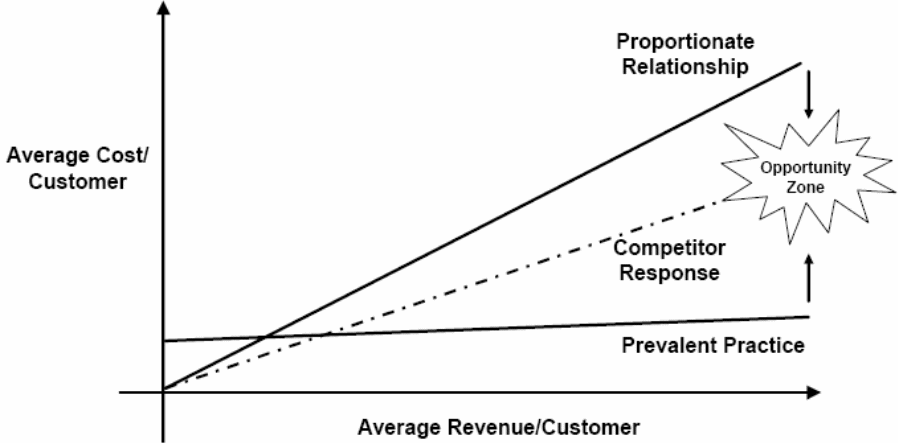
The above diagram explored the revenue and cost reallocation opportunity zone for the companies to integrate CRM program for their customers and the presentation argues that companies could choice to engage with an average cost per customer rather than spending proportionate to revenue generation by the concerned customer group.
Such alignment would provide cost-reducing plan for the CRM program, but this practice would facilitate the competitors to attract high-end customer by allocating high-end resources, which will seriously threaten the overall growth of the company. To resolute such dilemmas, another extensive model has presented as follows –
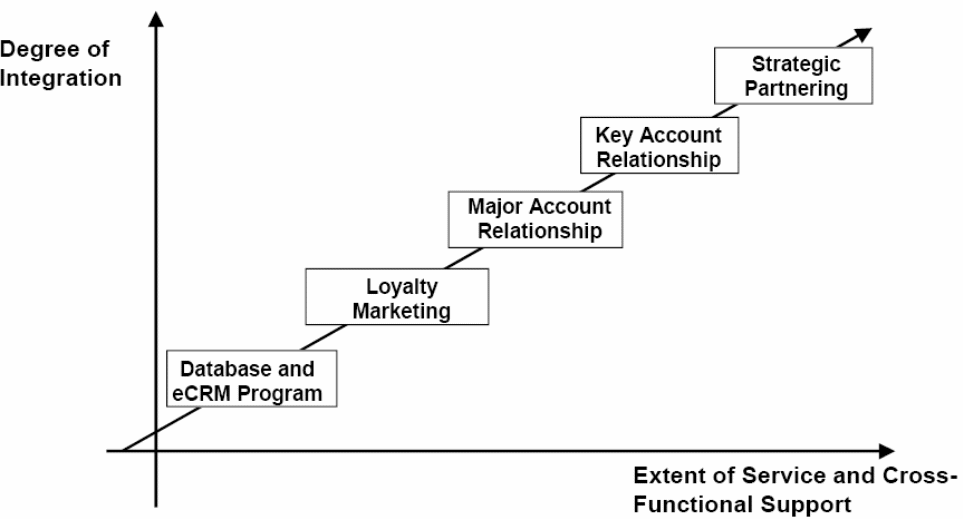
Above diagram demonstrated that by integrating the Information Technology and e-CRM the companies have the opportunity to incorporate a dynamic database for customers, where a fully automated system would control hierarchy based e-CRM program that facilitate to provide diverse services to the dissimilar customer groups based on loyalty marketing, individual customer’s account relationship and other development opportunities.
The CRM Governance Process
Borys and Jemison (1989, p. 237) argued that while any CRM scheme would be introduced, it essential for the companies to govern the entire process from the viewpoints of bilateral cooperation depending on the size and shape of the concerned market.
Both the customer and CRM program Initiator Company are liable to manage and sustain the relationship from mutual interest keeping a look to the market situation and competitors offering and encountering with improved offering time-to-time.
Not only the end customer, the companies necessarily emphasis and integrate the distributors and retail sellers under the CRM programs with enhanced opportunities, otherwise distributors and retailer would be attracted to the competitors, thus, it is most vital take the CRM program with diverse hybrid relationships.
Under the traditional CRM program, the relationship partners jointly or the company management solely governs the scheme, but in modern e-CRM goes under the IT department and an accelerated CRM scheme governed fully automated system integrating different CRM software like SAP.
Without huge human resource involvement, the software like SAP facilitate companies automated service stating from offering, invoicing, delivery assurance, feedback generation, customer’s accounts generation, online payments, automated survey taking and so on
CRM Performance Metrics
Sheth and Sisodia (1998, p16) pointed out that performance assessment of the CRM program is a vital factor for the sustainability of the scheme, rather than periodic assessment it necessity to conduct a regular evaluation and it is essential for the program coordinator to have performance measurement metrics.
Long evidence demonstrated that the balanced scorecard has been adopting for the performance measurement metrics of CRM scheme that provide a diversity of procedures pedestal on distinct rationale of program in every step.
Meanwhile, there is another globally recognized method of measuring performance of the CRM scheme, where the determination of relationship satisfaction like customer satisfaction measurement that provides indication for the existing supportive and mutual relationships between the customer and company.
The CRM Evolution Process
Parvatiyar and Sheth (2001, p.17) identified that the CRM scheme would take evaluation of every customer with the company through bilateral steps where few of them are predetermined and the others are generated by the way of practice including persistence, termination of the relation, its improvement and adjustment of the affiliation commitment.
The evaluation process would provide indication while the companies need to improve the facilities, when the customer would tend to terminate the relation; failure to addressing the expectation of the customer could not manage without reconfiguration of the entire system.
Thus, to overcome concerned risks of the relation, the CRM scheme would suggest the companies to conduct evaluation and get feedback from the customer after every sale take place and keep enough space to accommodate customers’ expectations.
Components of CRM and SCRM
Both Social Customer Relationship Management and Customer Relationship Management contain a number of essential components, and both are categorized in a series of events; the seven most crucial components of CRM have been given in the table below:
Table 2: Components of CRM. Source: Self generated from Lawson-Body & Limayem (2004).
According to Selvas (2010) and Metrics Marketing Group (2011), the key components of SCRM consist of the following outlined in the table below:
Table 3: Components of SCRM. Source: Self generated from Selvas (2010).
Comparison between CRM 1.0 and CRM 2.0
Some of the features of CRM 1.0 and CRM 2.0 are outlined in the following table:
Table 4: Comparison between CRM 1.0 and CRM 2.0. Source: Self generated from Dimitroff (2006).
Principles of CRM
Pivotal CRM (2007) suggested five key principles of CRM discussed in the subsequent sections of this paper; here, it has been pointed out that by acclimatizing a structural design of CRM, which is organized with the following five principles in mind, the basis for CRM-success can be further assured by the organization operating in any particular industry of the world.
Principle One
The CRM strategy of the corporation must fit with its strategic objectives and goals, and the workers must work in accordance to the way the corporation runs – with no alteration in the procedures, which make the corporation distinctive; moreover, the workers must possess access to all the consumer information they need, whenever they need it, and in their selected view.
Conversely, the corporation should construct the CRM vision first by describing a valuable consumer experience; it should also conduct its operations on the customers’ terms, with one global view, and innumerable local relationships, making user adoption a top priority.
Principle Two
The organization must formulate a precise Customer Relationship Management infrastructure, which works in compliance with its tactical decisions; on the other hand, the entire system must be flexible enough to build in complex business processes by ensuring better administration; and, most importantly, the CRM should help the organization to grow – and grow along with it.
Principle Three
CRM makes it simple to convey rapid and conversant service; at some point, the majority of businesses will have a need or want to calculate the success of CRM execution; so the objectives and metrics should be enumerated and bench-marked right from the beginning to make sure that the right information is detained to compute results correctly down the line.
Principle Four
The organizations must judge Total Cost of Ownership (TCO) cautiously and appreciate that industry- specific CRM lowers total costs; additionally, in order to handle cost expectations in due course, firms should analyze and conduct TCO with an apparent scrutiny; furthermore, a sound scaffold for evaluating results over the life of the project must be stated at the beginning.
Principle Five
The corporations must try to think beyond some confined features, and pick the right collaborator, as a helpful collaborator can make all the difference; they should use industry knowledge and experience to pay dividends; conversely, it is imperative to evaluate company aims, technology-strategy, IT-budgets, opportunity-costs, customization-requirements, and industry sector requirements before choosing a perfect CRM solution.
Reference List
Baird, C. & Parasnis, G. (2010). From social media to social customer relationship management. Emerald Group Publishing Limited, 30(5), 1-12. Web.
Baran, R. Zerres, C. & Zerres, M. (2009) Customer Relationship Management. Web.
Belch, G. E. & Belch, M.A. (2009). Advertising and Promotion. (8th ed.). London: McGraw Hill.
Berndt, A. Herbst, F. & Roux, L. (2005). Implementing a Customer Relationship Management Programme in an Emerging Market. Journal of Global Business and Technology, 1(2). Web.
Borys, B. & Jemison, D. B. (1989) Hybrid Arrangements as Strategic Allians: Theoretical Issues in Organizational Combinations. The Academy of Management Review, 14(2), 234 – 240. Web.
Chess Media Group (2010). Guide to Understanding Social CRM. Web.
Desai, D. (2010). Co-creating learning: insights from complexity theory. Emerald Group Publishing Limited, 17(5), 388-403. Web.
Dimitroff, V. G. (2006). Time for CRM 2.0. Web.
Doney, P. M. & Cannon, J. P. (1997). An Examination of the Nature of Trust in Buyer-Seller Relationships. Journal of Marketing, 61, 35-51. Web.
Dych, Ã., J. (2001). The CRM Handbook: A Business Guide to Customer Relationship Management. (1st ed.). New York, NY: Addison-Wesley Professional Publisher.
Friedrich, I. Sprenger, J. & Breitner, M. (2010) CRM Evaluation: An Approach for Selecting Suitable Software Packages. Web.
Ghosh, S. (1998). Making business sense of the Internet. Harvard Business Review, 2: 126-135.
Greenberg, P. (2009) CRM at the Speed of Light. 4th ed. Delhi: McGraw-Hill.
Greenberg, P. (2010). The impact of CRM 2.0 on customer insight. Journal of Business & Industrial Marketing, 25(6), 410-419. Web.
Gronroos, C. (1990). Relationship approach to marketing in service contexts: The marketing and organizational behavior interface. Journal of Business Research, 1(1): 3-11.
Gronroos, C. (1994). From marketing mix to relationship marketing: Towards a paradigm shift in marketing. Management Decision. 32(2): 4-20.
Gummesson, E. (1994). Making relationship marketing operational. International Journal of Service Industry Management, 5(5): 5-20.
Hampshire, S. (2010) Customer satisfaction, loyalty and profit – understanding the links. Web.
Kanellakis, N. (2005) Change Management and Customer Relationship Management (CRM) Implementations: Planning for Success. Web.
Kotler, P. & Keller, K. L. (2006) Marketing management. (12th ed.). New Jersey: Pearson Prentice Hall.
Kuusik, A. (2007) Affecting Customer Loyalty: Do Different Factors Have Various Influences In Different Loyalty Levels? Web.
Laudon, K. C., & Traver, C. G. (2002). E- commerce- Business, Technology, Society. (4th ed.). London: Dorling Kindersley Pvt. Ltd.
Lawson-Body, A. & Limayem, M. (2004). The Impact of Customer Relationship Management on Customer Loyalty: The Moderating Role of Web Site Characteristics. Journal of Computer-Mediated Communication, 9(4). Web.
Lieberman, M. (2011). The Evolution of CRM. Web.
Maklan, S. Knox S. & Peppard J. (2007). The Missing Link of CRM Profitability: Building Marketing Capabilities. Web.
Metrics Marketing Group (2011). Social CRM: Myths and Realities. Web.
Myhill, M. Shoebridge, M. & Snoo, L. (2009). Virtual research environments – a Web 2.0 cookbook? Emerald Group Publishing Limited, 27(2), 0737-8831. Web.
O’Reilly, T. (2005). What is Web 2.0? Web.
Oztaysi, B. Sezgin, S. & Ozok, A. (2011). A measurement tool for customer relationship management processes. Industrial Management & Data Systems, 111(6), 943-960. Web.
Nguyen, T. Joseph, S. Newby, S. (2007). Strategies for successful CRM implementation. Information Management & Computer Security, 15(2), 102 – 115. Web.
Parvatiyar, A. & Sheth, J. N. (2001). Customer Relationship Management: Emerging Practice, Process, and Discipline. Journal of Economic and Social Research 3(2), 1-34. Web.
Payne, A. (1994). Relationship marketing making the customer count. Managing Service Quality, 4(6): 29-31.
Pearson. (2009). What is CRM and Why is it Important? Web.
Pelland, T. (2007) Customer Service A Revolutionary Change. Journal of the Quality Assurance Institute, 21(2).
Peppers, D. & Rogers, M. (2004) Managing Customer Relationships: A Strategic Framework. 1st ed. London: Wiley.
Pivotal CRM (2007). CRM: The Essential Guide. Web.
Ryals, L. & Payne, A. (2001) Customer relationship management in financial services: towards information-enabled relationship marketing. Journal of Strategic Marketing, 9. Web.
Santoso, L. W. (2008) CRM Adoption Framework and Its Success Measurement. Web.
Schubert, P. (2003). Personalizing e-commerce applications in SMEs. Americas Conference on Information Systems, 9: 737-750.
Selvas, F. (2010). Components of a Social CRM platform. Web.
Sheth, J. N., & Parvatiyar, A. (1995). Relationships marketing in consumer markets: Antecedents and consequences. Journal of Academy of Marketing Science, 23(4): 255-271.
Sheth, J. N. & Parvatiyar, A. (1995). The Evolution of Relationship Marketing. International Business Review, 4, 1-38. Web.
Sheth, J. N. & Sisodia, R. S. (1998). Improving Marketing Productivity: Issues and Analysis. Journal of Business Research, 1 -25. Web.
Tredinnick, L. (2008). Complexity theory and the web.Journal of Documentation, 65(5), 797-816. Web.
Urbanskienė, R. et al. (2008) The Model of Creation of Customer Relationship Management (CRM) System. Web.
Wilson, D. T. (1995). An Integrated Model of Buyer-Seller Relationships. Web.